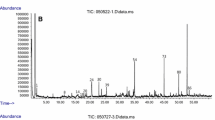Abstract
An analytical technique employing gas chromatography and tandem mass spectrometry (GC/MS/MS) was employed to systematically screen fifty-eight wheat accessions for their differential production of 2,4-dihydroxy-7-methoxy-1,4-benzoxazin-3-one (DIMBOA) from three consecutive sources, i.e., the shoots, roots, and in the associated agar growth medium (collected as root exudates) of 17-day-old wheat seedlings. DIMBOA content differed significantly in the shoots, roots, or in the agar growth medium between accessions. DIMBOA accumulated differentially within the plant, with roots containing more DIMBOA than the shoots. Only 19% of accessions were able to exude DIMBOA from living roots into their growth medium, indicating the exudation of DIMBOA is accession-specific. DIMBOA level in root tissues is expected to be high when a high level of DIMBOA content is detected in the shoots. Wheat seedlings did not release detectable amounts of DIMBOA when the DIMBOA level was low in the root tissues. The valuable genetic material with high levels of DIMBOA in the shoots or roots identified in the present research could be used to breed for wheat cultivars with elevated allelopathic activity.
Similar content being viewed by others
REFERENCES
ANONYMOUS. 1995. Genstat 5 Release 3.2 Manual (PC/Windows NT ). Lawes Agricultural Trust (Rothamsted Experimental Station), Oxford University Press, New York, USA.
BARNES, J. P., and PUTNAM, A. R. 1987. Role of benzoxazinones in allelopathy by rye (Secale cereale L.). J. Chem. Ecol. 13:889–905.
BLUM, U., GERIG, T. M., WORSHAM, A. D., HOLAPPA, L. D., and KING, L. D. 1992. Allelopathic activity in wheat-conventional and wheat-no-till soils: Development of soil extract bioassays. J. Chem. Ecol. 18:2191–2221.
BOHIDAR, K., WRATTEN, S. D., and NIEMEYER, H. M. 1986. Effects of hydroxamic acids on the resistance of wheat to the aphid Sitobion avenae. Ann. Appl. Biol. 109:193–198.
COPAJA, S. V., NIEMEYER, H. M., and WRATTEN, S. D. 1991. Hydroxamic acid levels in Chilean and British wheat seedlings. Ann. Appl. Biol. 118:223–227.
COPAJA, S. V., NICOL, D., and WRATTEN, S. D. 1999. Accumulation of hydroxamic acids during wheat germination. Phytochemistry 50:17–24.
DUNN, G. M., LONG, B. J., and ROUTLEY, D. G. 1981. Inheritance of cyclic hydroxamates in Zea mays L. Can. J. Plant Sci. 61:583–593.
EINHELLIG, F. A. 1995. Allelopathy: Current status and future goals, pp.1–24, in Inderjit, K. M. M. Dakshini, and F. A. Einhellig (eds.). Allelopathy: Organisms, Processes, and Applications, ACS Symposium Series No. 582, Washington, D.C.
FIGUEROA, C. C., KOENIG, C., ARAYA, C., SANTOS, M. J, and NIEMEYER, H. M. 1999. Effect of dimboa, a hydroxamic acid from cereals, on peroxisomal and mitochondrial enzymes from aphids: Evidence for the presence of peroxisomes in aphids. J. Chem. Ecol. 25:2465–2475.
FRIEBE, A., SCHULZ, M., KUCK, P., and SCHNABL, H. 1995. Phytotoxins from shoot extracts and root exudates of Agropyron repens seedlings. Phytochemistry 38:1157–1159.
GASPAR, E. M., and NEVES, H. C. 1993. Steroidal constituent from mature wheat straw. Phytochemistry 34:523–527.
GASPAR, E. M., and NEVES, H. C. 1995. Chemical constituents in allelopathic straw of wheat (Triticum aestivum L.). Allelopathy J. 2:79–87.
KLUN, J. A., GUTHRIE, W. D., HALLAUER, A. R., and RUSSELL, W. A. 1970. Genetic nature of the concentration of 2,4-dihydroxy-7-methoxy 2H-1,4-benzoxazin-3 (4H)-one and resistance to the European corn borer in a diallel set of eleven maize inbreds. Crop Sci. 10:87–90.
LESZCZYNSKI, B., DIXON, A. F. G., BAKOWSKI, T., and MATOK, H. 1995. Cereal allelochemicals in grain aphid control. Allelopathy J. 2:31–36.
NEVES, H. C., and GASPAR, E. M. 1990. Identification of active compounds in wheat straw extracts with allelopathic activity by HRGC-MS and HRGC-FTIR. J. High Resol. Chromatogr. 13:550–554.
NICOL, D., COPAJA, S. V., WRATTEN, S. D., and NIEMEYER, H. M. 1992. A screen of worldwide wheat cultivars for hydroxamic acid levels and aphid antixenosis. Ann. Appl. Biol. 121:11–18.
NIEMEYER, H. M. 1988a. Hydroxamic acids (4-hydroxy-1,4-benzoxazin-3-one), defence chemicals in the gramineae. Phytochemistry 27:3349–3358.
NIEMEYER, H. M. 1988b. Hydroxamic acid content of Triticum species. Euphytica 37:289–293.
NIEMEYER, H. M., and JEREZ, J. M. 1997. Chromosomal location of genes for hydroxamic acid accumulation in Triticum aestivum L. (wheat) using wheat aneuploids and wheat substitution lines. Heredity 79 (Part 1):10–14.
PéREZ, F. J. 1990. Allelopathic effect of hydroxamic acids from cereals on Avena sativa and A. fatua. Phytochemistry 29:773–776.
PéREZ, F. J., and ORMEÑ-NÚÑEZ, J. 1991. Difference in hydroxamic acid content in roots and root exudates of wheat (Triticum aestivum L.) and rye (Secale cereale L.): Possible role in allelopathy. J. Chem. Ecol. 17:1037–1043.
Pethó, M. 1992. Occurrence and physiological role of benzoxazinones and their derivatives. III. Possible role of 7-methoxybenzoxazinone in the iron uptake of maize. Acta Agron. Hung. 41:57–64.
RICE, E. L. 1984. Allelopathy. 2nd ed. Academic Press, Orlando, Florida.
SIMCOX, K. D., and WEBER, D. F. 1985. Location of benzoxazinless (bx) locus in maize by monosomic and B-A translocational analyses. Crop Sci. 25:827–830.
WILKES, M. A., MARSHALL, D. R., and COPELAND L. 1999. Hydroxamic acids in cereal roots inhibit the growth of take-all. Soil Biol. Biochem. 31:1831–1836.
WU, H., HAIG, T., PRATLEY, J., LEMERLE, D., and AN, M. 1999. Simultaneous determination of phenolic acids and 2,4-dihydroxy-7-methoxy-1,4-benzoxazin-3-one by GC/MS/MS in wheat (Triticum aestivum L.). J. Chromatogr. A. 864:315–321.
WU, H., PRATLEY, J., LEMERLE, D., and HAIG, T. 2000. Laboratory screening for allelopathic potential of wheat (Triticum aestivum) accessions against annual ryegrass (Lolium rigidum). Aust. J. Agric. Res. 51:259–266.
Author information
Authors and Affiliations
Rights and permissions
About this article
Cite this article
Wu, H., Haig, T., Pratley, J. et al. Allelochemicals in Wheat (Triticum aestivum L.): Production and Exudation of 2,4-Dihydroxy-7-Methoxy-1,4-Benzoxazin-3-One. J Chem Ecol 27, 1691–1700 (2001). https://doi.org/10.1023/A:1010422727899
Issue Date:
DOI: https://doi.org/10.1023/A:1010422727899




